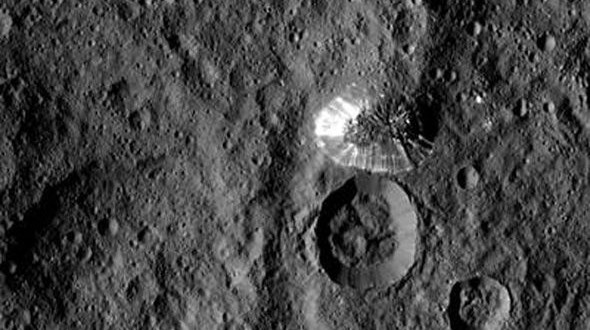AN ASTOUNDING picture showing a bizarre four-mile high cone-shaped mountain rising from an otherwise flat landscape on dwarf-planet Ceres has been released by Nasa.
While using its framing camera to map the dwarf planet’s surface at an orbital altitude of 915 miles (1,470 kilometers) on August 19, Dawn managed to get an up-close look at the four mile (six kilometer) tall mountain. The image was taken at a resolution of 450 feet (140 meters) per pixel, and reveals narrow, braided fractures and an unusual bright region.
NASA also released images of a mountain ridge in the center of Urvara crater, and Gaue crater, a large crater with a sunken-in center. Urvara crater is 101 miles (163 kilometers) in diameter and was named after an Indian and Iranian deity of plants and fields, while Gaue crater is was named after a Germanic goddess and is 52 miles (84 kilometers) in diameter.
Dawn mapping gravity field in preparation for final orbit
At its current altitude, Dawn takes 11 days to capture and transmit images of Ceres’ surface back to Earth, according to NASA. Each of those 11-day cycles 14 orbits, the agency added, and over the next eight weeks, the spacecraft will successfully map the dwarf planet’s entire surface a total of six times. That data will allow NASA scientists to create 3D models of Ceres.
During this time, Dawn will also gather data can will provide new insight into the minerals found on the surface of Ceres using its visible and infrared mapping spectrometer instruments.
Furthermore, mission scientists and engineers are in the process of refining their measurements of Ceres’ gravitational field, and that information will be used to help design Dawn’s next orbit, which will be its lowest. This final orbit will be at an altitude of just 230 miles (375 kilometers), and the spacecraft will begin its descent to this height in late October.
“Dawn is performing flawlessly in this new orbit as it conducts its ambitious exploration,” Dawn chief engineer and mission director Marc Rayman from the Jet Propulsion Laboratory (JPL) in Pasadena, California, said in a statement. “The spacecraft’s view is now three times as sharp as in its previous mapping orbit, revealing exciting new details of this intriguing dwarf planet.”
Agencies/Canadajournal
 Canada Journal – News of the World Articles and videos to bring you the biggest Canadian news stories from across the country every day
Canada Journal – News of the World Articles and videos to bring you the biggest Canadian news stories from across the country every day



